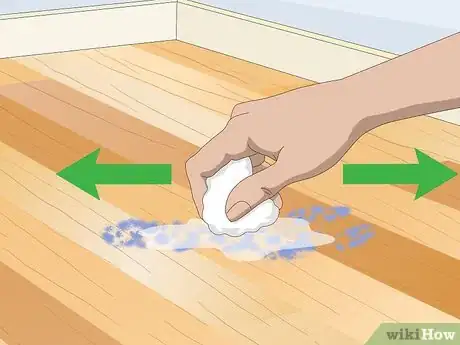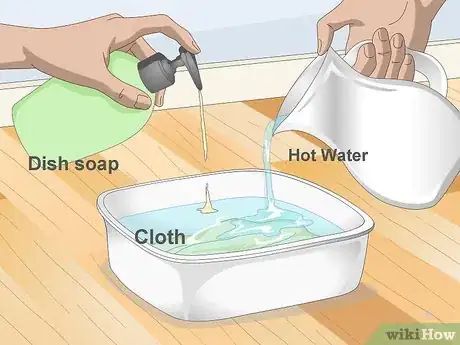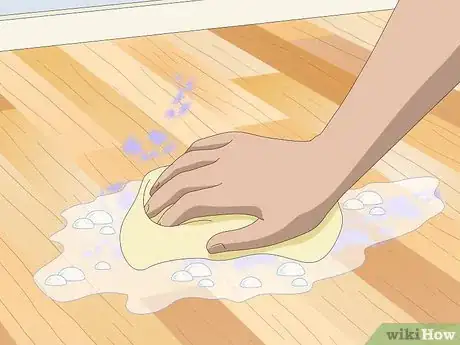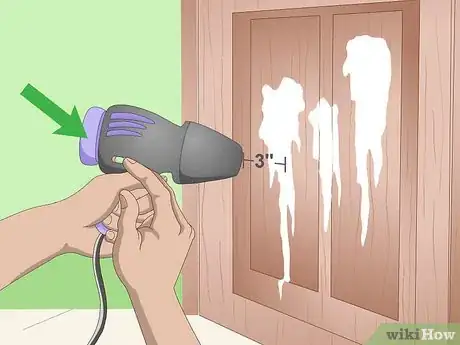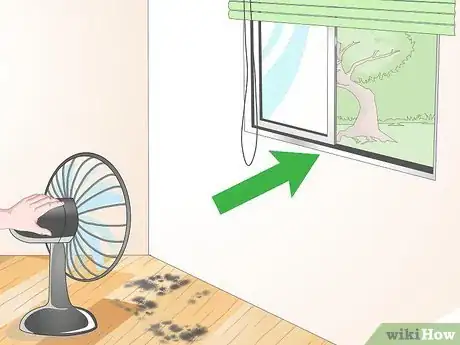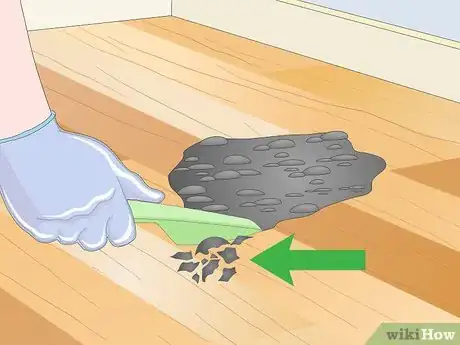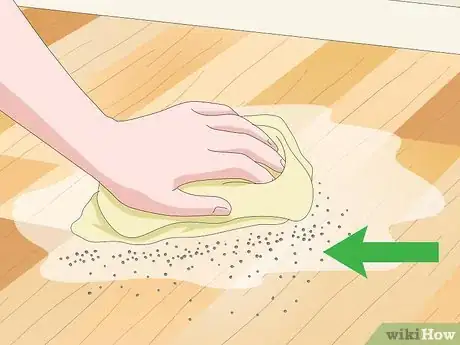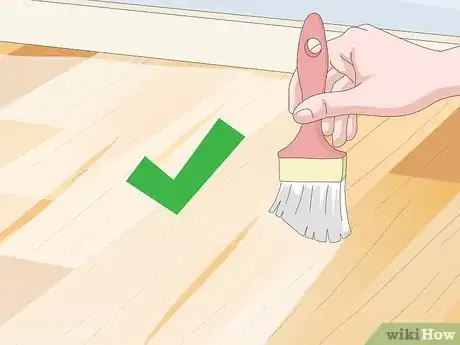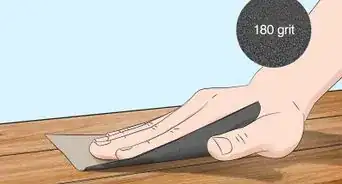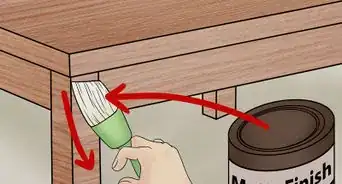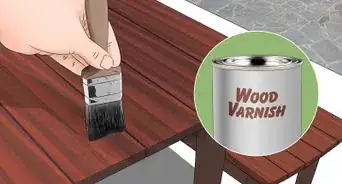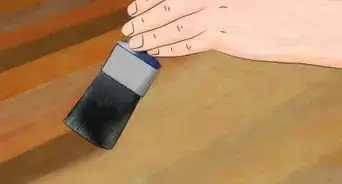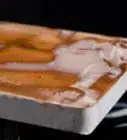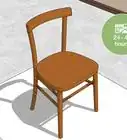This article was co-authored by Crystal Chadwick. Crystal Chadwick is a Licensed General Contractor and the Owner of Yin & Yang Construction out of Salt Lake City, Utah. With over 16 years of experience in the construction industry, she specializes in remodels, repairs, and handyman services. Crystal leads her team with vision and a detail-oriented approach, allowing them to provide quality work and design to their clients.
There are 7 references cited in this article, which can be found at the bottom of the page.
This article has been viewed 214,697 times.
Acrylic paint is water-based and can be removed from wood using a variety of methods. Though dealing with a paint spill immediately after it happens is best, you can remove both wet and dry paint using soap and water, rubbing alcohol, a heat gun, solvents, or sandpaper.
Steps
Using Rubbing Alcohol
-
1Scrape the paint stain with a putty knife. Try to gently chip off as much of the top layer of paint as possible. Any paint you can remove this way will be less paint that the alcohol has to cut through. Be careful not to dig into the wood and leave scratch marks behind.
-
2Apply some alcohol on a cloth. Use basic rubbing alcohol, which can be purchased at most drugstores or grocery stores. Place the cloth on top of the open bottle and shake it once or twice to saturate a small section of the cloth.Advertisement
-
3Rub the remaining paint with the cloth. Keep adding alcohol to the cloth and continue rubbing until all the paint is gone. Alcohol can damage the wood's finish, so only use it on the exact area of the paint stain.
-
4Wipe the alcohol away. Moisten a clean cloth with a bit of water and wipe the area with it to remove all the remaining residue. The wood may still smell of alcohol, but that will dissipate over time.
-
5Wipe the surface with a dry cloth. Rub the damp spot until all excess moisture is removed. The wood will still be wet, but should dry within 24 hours.
Using Soap and Water
-
1Wipe fresh acrylic paint with a wet cloth. Dampen a washcloth or rag slightly and try to wipe away as much of the paint as you can. Switch out the cloth as needed if it becomes too saturated.
- This may be ineffective on paint stains that have been dry for awhile. Soap and water are most effective on fresh paint stains.[1]
-
2Moisten a fresh cloth with hot water and put some soap on it. Use a basic glycerin soap, like dish soap, that will produce a good lather and get into the grain of the wood. You can use liquid or bar soap for this.
-
3Scrub the remaining paint gently with the soapy cloth. Keep scrubbing and adding more soap until all the paint is gone. Rub the cloth in straight lines with the grain of the wood to try and get all the paint out of the grooves.
-
4Wipe the area with a damp cloth to remove the soap residue. Continue to wipe at the spot until the soap suds are gone. You may need to rinse the cloth once if the spot was really soapy.
-
5Use a dry cloth or towel to dry the area. Wipe away as much excess water as possible. The wood will remain damp, and may take up to 48 hours to fully dry depending on the size of the spot.[2]
Using a Heat Gun
-
1Determine if the painted area is large enough to use a heat gun. If you're removing paint from an entire door or piece of furniture, using a heat gun may be worthwhile. If you only need to remove a few small spots, then other methods, like soap or alcohol, may be a more practical choice.
- If you decide to use a heat gun and wish to buy one, they are relatively inexpensive and can be purchased at craft stores and hardware stores.
-
2Read all product instructions carefully. You can char the wood, and even start a fire, if you use too high a setting. Read the safety instructions to be sure you know the proper way to use the heat gun.
- Melting paint can also create harmful vapors, so be sure to wear protective gear like safety goggles and a mask or respirator.[3]
-
3Aim the gun at the paint and turn it on. Hold it 3-4 inches (7-10 centimeters) away from the stain for about 10-20 seconds at a time. Try moving it in small circular motions to heat a larger area at once.[4]
-
4Scrape at the stain with a putty knife. While holding the heat gun with one hand, try to get under the stain with the edge of the knife. The paint should begin to soften and peel away. Clean off the putty knife as needed and continue scraping until all the paint is gone.
- Turn off the heat gun any time you set it down to clean the putty knife.
-
5Wipe down the surface once it’s cool. Wait until the wood is no longer hot, and wipe it with a damp cloth to remove any remaining residue. You can add some soap to the cloth for added cleaning power (see method above for full instructions).
Using a Solvent
-
1Choose a solvent. The most common paint stripper is methylene chloride. It’s extremely potent and should be used with care. There are solvents that are citrus-based and more environmentally friendly, but these are still dangerous and proper safety precautions should be taken.[5]
- Solvents can be purchased at your local hardware or paint store.
-
2Put on safety gear. Wear eye protection, like safety glasses or goggles, and a ventilation mask to protect yourself from the harmful vapors. It’s also a good idea to wear gloves and long sleeves since the product could splash.[6]
-
3Create proper ventilation. Work outside if possible, but if the wood can’t be moved, open all windows and doors. Set a fan behind you so that the airflow blows the fumes away from you and out a window or door.
-
4Roll or brush on solvent. Use a paintbrush or paint roller to apply a thin coat of the solvent to the paint. Allow it to sit for about 20 minutes, or however long the instructions recommend.[7] The paint will begin to bubble as the solvent is working.
-
5Scrape off bubbled paint. Use a blunt plastic scraper to scratch off the paint that has begun bubbling and peeling. Avoid using sharp metal tools that will gauge the wood. Collect the peeling paint in a disposable container or plastic bag.
-
6Cleanse the area with mineral spirits. Some manufacturers claim that water alone will clean the area, but the best way to ensure the wood is neutralized is to wipe it with a rag soaked in mineral spirits.[8]
-
7Wait a week to refinish the wood. Give the wood at least a week to completely dry and air out before you attempt to apply any stains or waxes.
Sanding the Wood
-
1Rub the paint using steel wool or sandpaper. Use #0000 steel wool or fine sandpaper (150-180 grit). If there’s a lot of paint to remove, start with a coarser sandpaper, like 80-120 grit or, in extreme cases, 40-60 grit.[9] Do this very gently to remove only the paint.
- Large areas can be sanded with power sanders, but be sure to wear a protective mask and safety glasses and read all product instructions carefully.
-
2Clean the wood with a damp cloth. Run a wet rag over the wood to wipe away sawdust and debris. Swap the cloth out for a fresh one if it becomes too dirty while you’re cleaning.
-
3Refinish the wood. Once it’s dry again, touch up the wood using the same finish or stain that was used on it before. If you don’t have any extra or don’t know what was used on it, try to match it as closely as possible with samples from your local hardware store.
Expert Q&A
-
QuestionAre there any other products I can use to do this?
 Crystal ChadwickCrystal Chadwick is a Licensed General Contractor and the Owner of Yin & Yang Construction out of Salt Lake City, Utah. With over 16 years of experience in the construction industry, she specializes in remodels, repairs, and handyman services. Crystal leads her team with vision and a detail-oriented approach, allowing them to provide quality work and design to their clients.
Crystal ChadwickCrystal Chadwick is a Licensed General Contractor and the Owner of Yin & Yang Construction out of Salt Lake City, Utah. With over 16 years of experience in the construction industry, she specializes in remodels, repairs, and handyman services. Crystal leads her team with vision and a detail-oriented approach, allowing them to provide quality work and design to their clients.
Licensed General Contractor You could use some Goof-Off, but it might damage the finish of the wood. If you go that route, you may need to touch up the finish in that spot.
You could use some Goof-Off, but it might damage the finish of the wood. If you go that route, you may need to touch up the finish in that spot. -
QuestionHow do I remove an acrylic stain from wood without stripping or sanding?
 Community AnswerRazor it down, there will still be acrylic in the grain. Follow up with a cotton swab and thinner.
Community AnswerRazor it down, there will still be acrylic in the grain. Follow up with a cotton swab and thinner. -
QuestionHow do I remove an acrylic spill from wood without stripping or sanding?
 AutumnBombCommunity AnswerRazor it down, there will still be acrylic in the grain. Follow up with a cotton swab and thinner.
AutumnBombCommunity AnswerRazor it down, there will still be acrylic in the grain. Follow up with a cotton swab and thinner.
Things You'll Need
- Soft cloths or small towels
- Putty knife or paint scraper
- Paint brush or roller
- Glycerin soap
- Steel wool (#0000) or a fine sandpaper (150-180 grit)
- Rubbing alcohol
- Paint solvent
- Heat gun
References
- ↑ http://www.acmehowto.com/cleaning/wood-paint.php
- ↑ http://homeguides.sfgate.com/soon-after-cleaning-deck-can-stain-seal-78024.html
- ↑ https://www.thisoldhouse.com/ideas/read-you-strip-paint-wood/page/7
- ↑ http://www.doityourself.com/stry/when-and-how-to-use-a-heat-gun-for-paint-removal
- ↑ http://www.paintpro.net/Articles/PP303/PP303_strippers.cfm
- ↑ http://www.diynetwork.com/how-to/skills-and-know-how/painting/how-to-remove-paint-with-chemical-strippers
- ↑ http://www.diynetwork.com/how-to/skills-and-know-how/painting/how-to-remove-paint-with-chemical-strippers
- ↑ http://www.paintpro.net/Articles/PP303/PP303_strippers.cfm
- ↑ http://homeguides.sfgate.com/sand-paint-wood-28593.html
About This Article
To remove acrylic paint from wood using soap and water, wipe up as much spilled paint as you can with a damp cloth. Then, dip a fresh cloth in a solution of dish soap and water and scrub it over the remaining paint spots. For older paint stains, scrape the area with a putty knife to chip off as much paint as possible. Then, scrub the area clean with an alcohol-dampened cloth.


